
Adam Volumes in Sir John Soane’s Museum
Lorraine BryantSir John Soane (1753–1837), architect and teacher, amassed a vast collection of sculpture, paintings, architectural drawings, models, books and other objects. These were arranged in his house museum in London to benefit the education of students and amateur architects and artists. This legacy, preserved by an Act of Parliament to remain unaltered, was left to the nation on Soane’s death. It includes 9,000 drawings from Soane’s own practice in addition to 30,000 architectural, design and topographical drawings with fine examples from the Renaissance through to the end of the Regency period. Amongst these Soane purchased a variety of collections in albums and these include 57 volumes containing drawings relating to the Scottish architects Robert (1728–1792) and James (1732–1794) Adam.
Two of the Adam volumes (56–57) stem from Soane’s purchases at the 1818 Adam Sale, the remainder (1–55) came through private sale from the Adam family in 1833.[1] The collation of the drawings into album format was almost exclusively at the hands of younger brother William and niece Susannah Clerk to help find a contemporary buyer,[2] although the arrangement of some albums could pre-date that intervention.
1000 of the drawings, now catalogued as ‘travel drawings’,[3] are mostly from the period of the Grand Tour and the Adam brothers’ time in Rome between 1754 and 1763. This large corpus of work, produced and collected during the brothers’ travels, led to the formation of the neoclassical style that under-pinned their successful architectural business. As such it is a primary resource for scholars.
Over 200 years, to allow continued access to the drawings for research, many bindings have undergone stages of repair or replacement. There have been calls from art historians to remove the contents to allow greater opportunity for study and display of individual drawings, however the archaeology, mounting arrangement and binding structures are also significant due to their Adam family origin and each volume as a composite object has value as an artefact. Furthermore, keeping the original materials and format intact preserves the collection as used by Soane and maintains the aesthetic of his Regency home and museum as well as preserving indications of provenance and original use of the albums.
Evidence suggests that Robert Adam collated Volume 55 during his studies in Rome between 1755 and 1757. It is a full parchment folio stationery binding (425 x 295 x 28 mm). The support leaves, in a cream handmade laid paper of medium weight, have the watermark fleur-de-lis in a double circle monogramed CC. This is comparable to those found in etchings from the workshop of Adam’s mentor Giovanni Battista Piranesi from 1756 to 1757, therefore indicating similar mid-18th-century Italian origin.[4] An ink inscription written directly onto the album page in Robert’s hand, states ‘All the sketches that follow were drawn abroad to the Number of…’[5] (Fig. 1). Three are drawn on the album pages, interspersed with those trimmed from other sketchbooks and mounted with glue spots, some on one side only to ensure easy access to versos, along with examples by his teachers. The 182 drawings, mounted close together or overlapping, indicate a desire to collate an album resource of many selected images related to his academic study (Fig. 2). There are a variety of media, but mainly iron gall ink, and a few drawings are tinted with wash that flows onto the album page and must therefore have been added after the drawings were placed in the album.
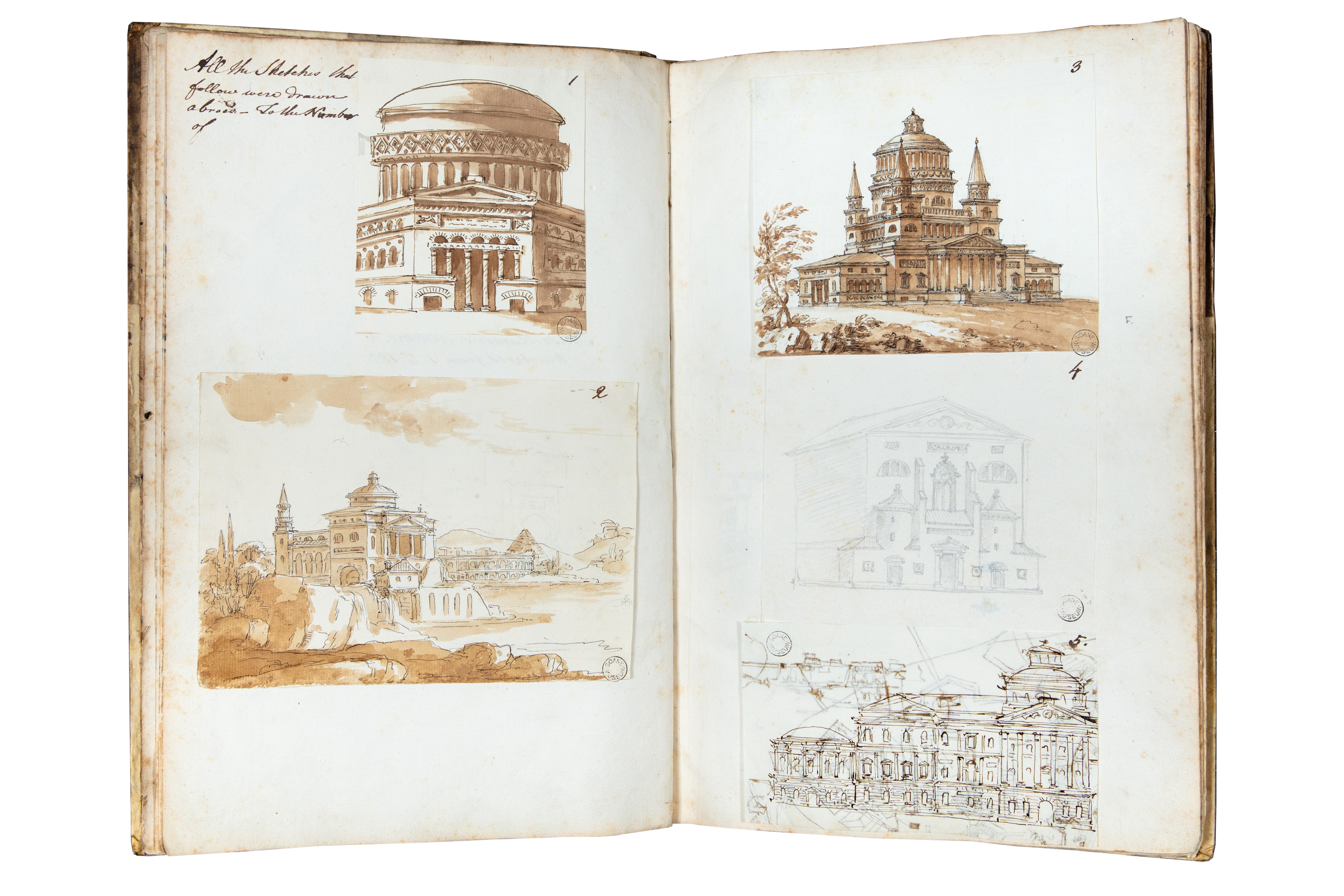 ©Sir John Soane’s Museum. Photo: Lewis Bush | 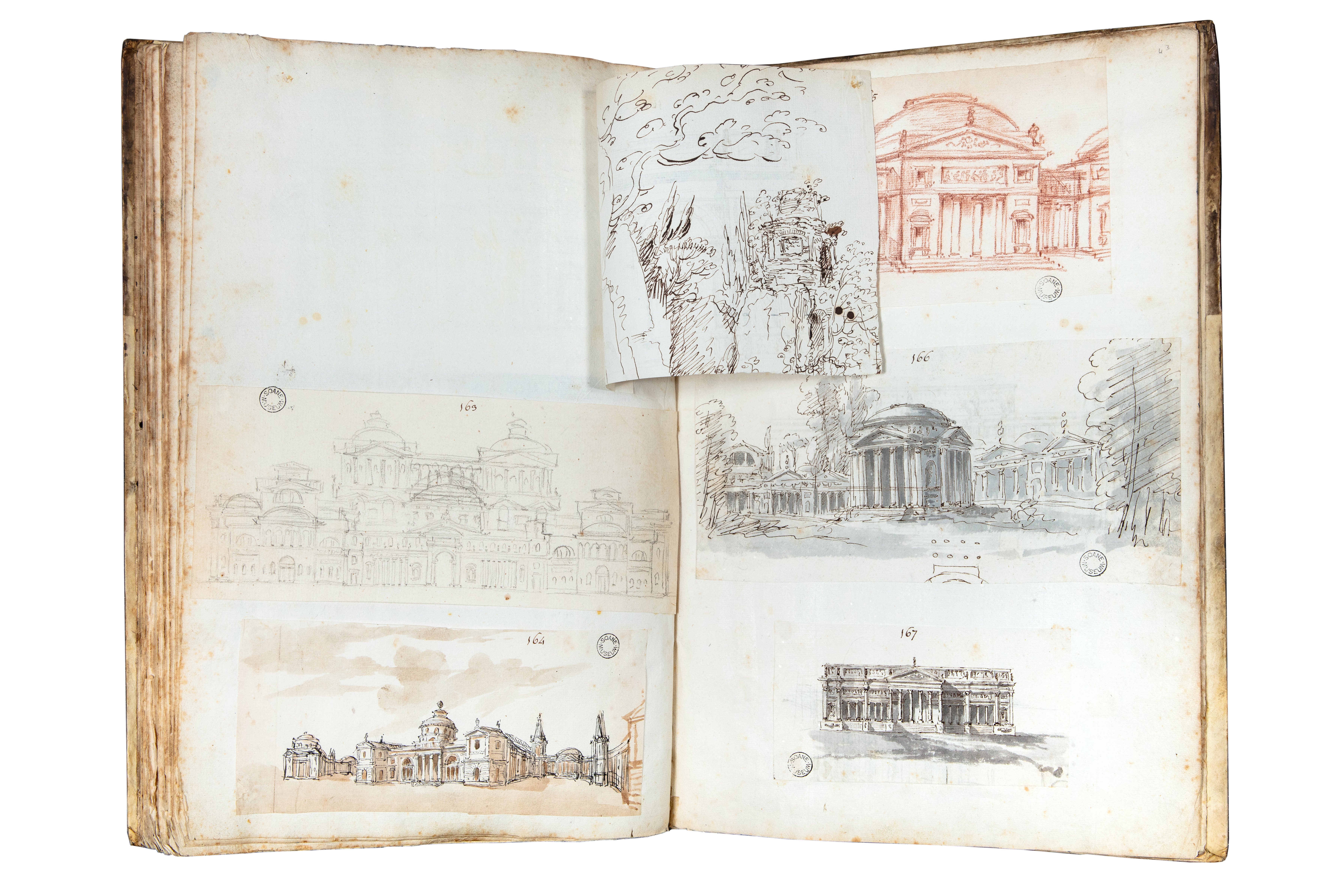 ©Sir John Soane’s Museum. Photo: Lewis Bush |
Letters sent by Robert state drawing materials were hard to find in Rome; when he wrote that “neither […] pencils, paper nor anything can be got here for love nor money”)[6], we can fathom that the album’s content was at least to some extent a hard-won treasure. That the whole collection became a cherished resource is evident also from its many signs of use including the scratched parchment binding with ink stains, scorch mark on the back cover and polished appearance (Fig. 3). However, subsequent use of the album in Robert’s architectural practice, or in Soane’s lifetime by students cannot be ignored. Over time the album has gained the patina of age that unites it with Soane’s collection. In its unaltered format the signs of provenance and use remain and are important to preserve, as they are intrinsic to the history and character of the album. The composite object provides a unique personal record of this period in Adam’s training.
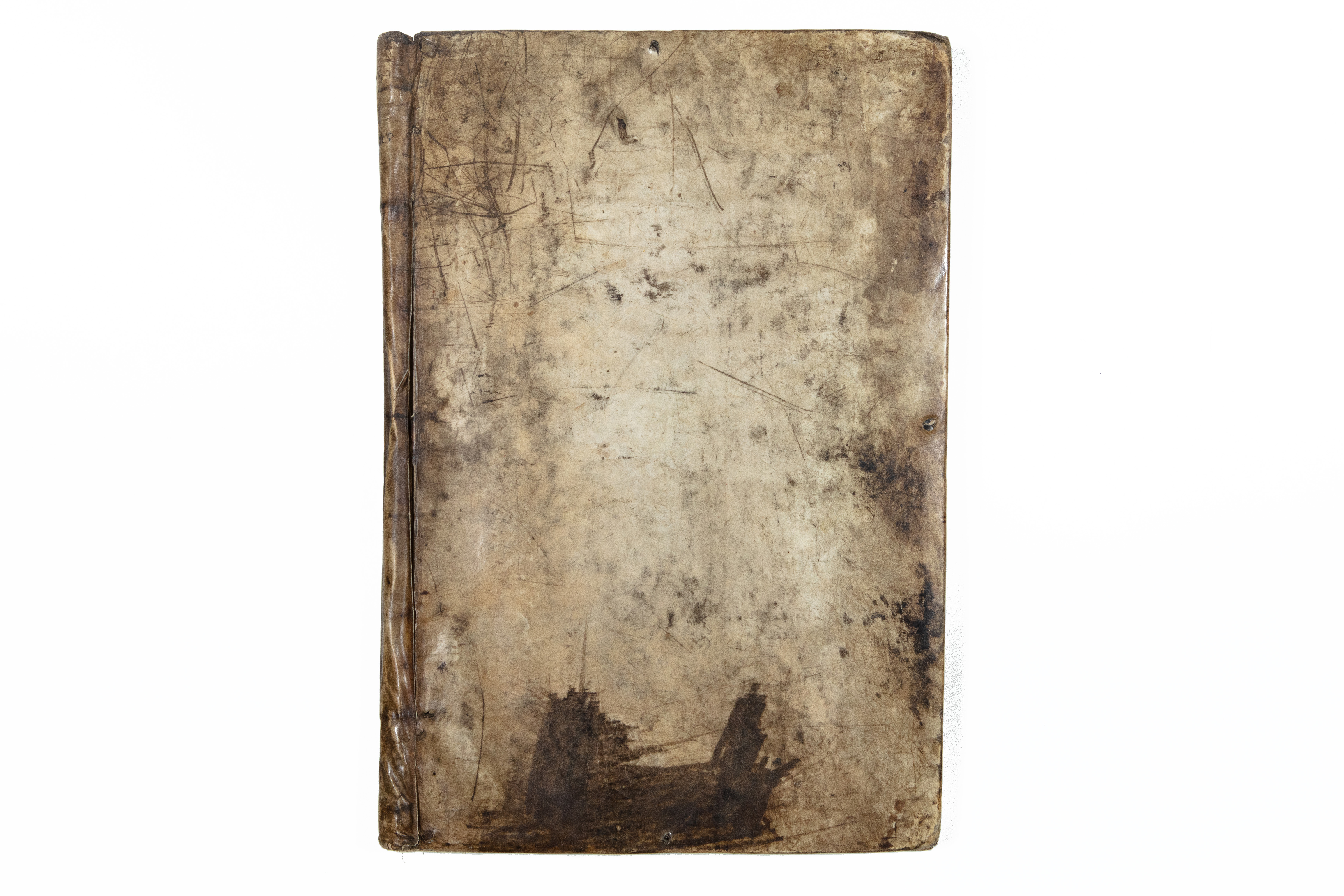 ©Sir John Soane’s Museum. Photo: Lewis Bush |  ©Sir John Soane’s Museum. Photo: Lewis Bush |
The contents of Volume 26 relate to James Adam’s time in Rome 1760–63. The original extra-large folio binding is full leather with dark brown mottled finish and blind tooling (615 x 480 x 75 mm) and may also be from the same period (Fig. 4). The support leaves are heavy weight handmade laid paper with a watermark fleur-de-lis in a single circle surmounted with the monogram V also found in other Roman corpora of work from the 1750s and 60s.[7] The 201 drawings, all roughly trimmed before attaching with glue spots or wax, some folded or separated into sections to accommodate their larger format, were arranged to effectuate a space-saving but ordered display to fill the whole volume. Leather thongs at foredge, head and tail, now missing, would have helped reduce the resulting swell of the volume.
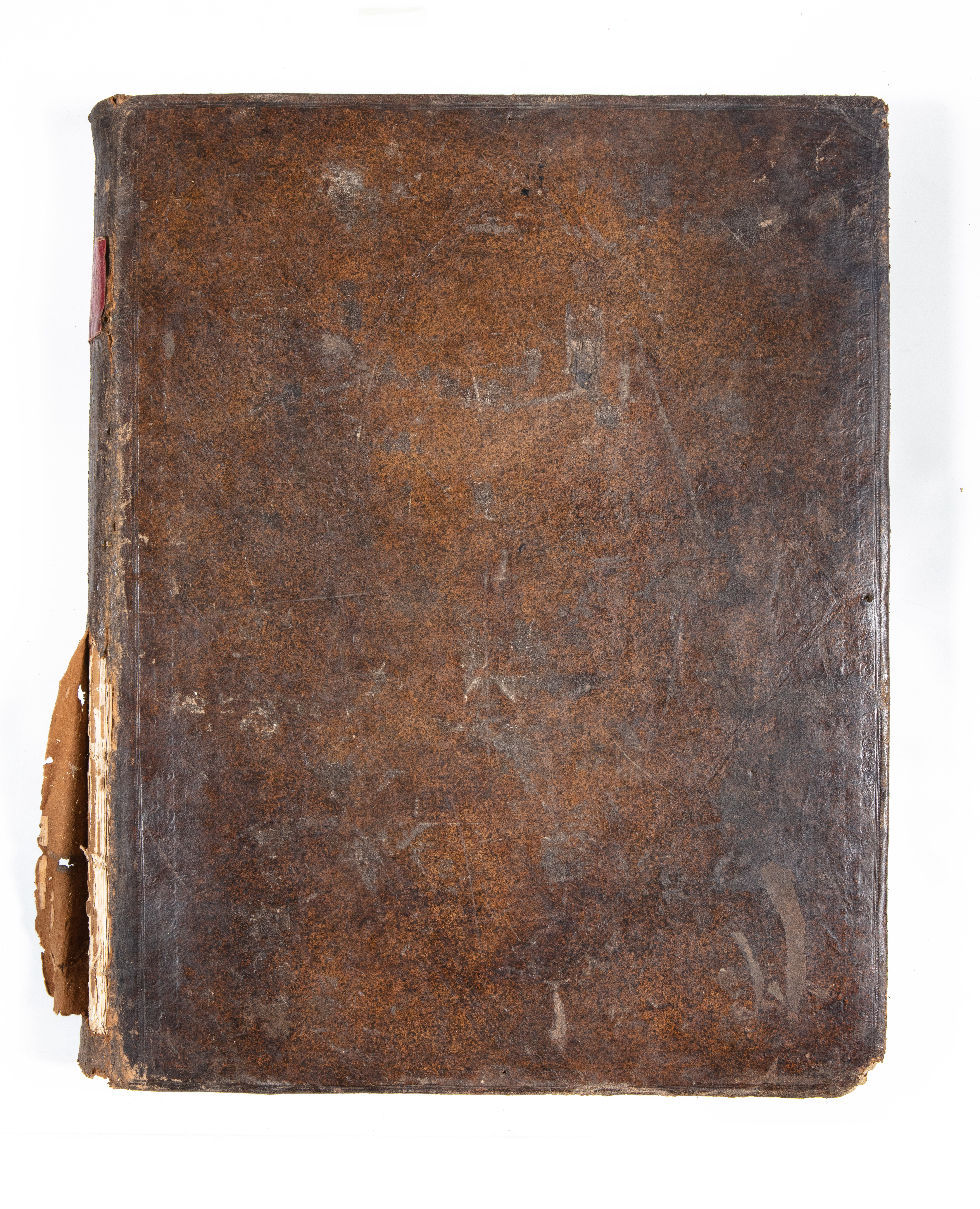 ©Sir John Soane’s Museum. Photo: Lewis Bush |
The drawings in Volume 26 were produced by the brothers’ Roman circle of draughtsmen, teachers and mentors, in a diversity of media and hand-made papers, include many highly finished drawings (Fig. 5). They were commissioned or bought as records of ornamentation, examples of architectural composition and contemporary draughtsmanship including copies, as well as counterproofs[8], of other drawings from this architectural context. Some are detailed drawings of antiquities that were possibly informally for sale.[9] They combine to provide a record of James’s connoisseurship and probably served as inspiration in the brothers’ new architectural practice.
 ©Sir John Soane’s Museum. Photo: Lewis Bush | 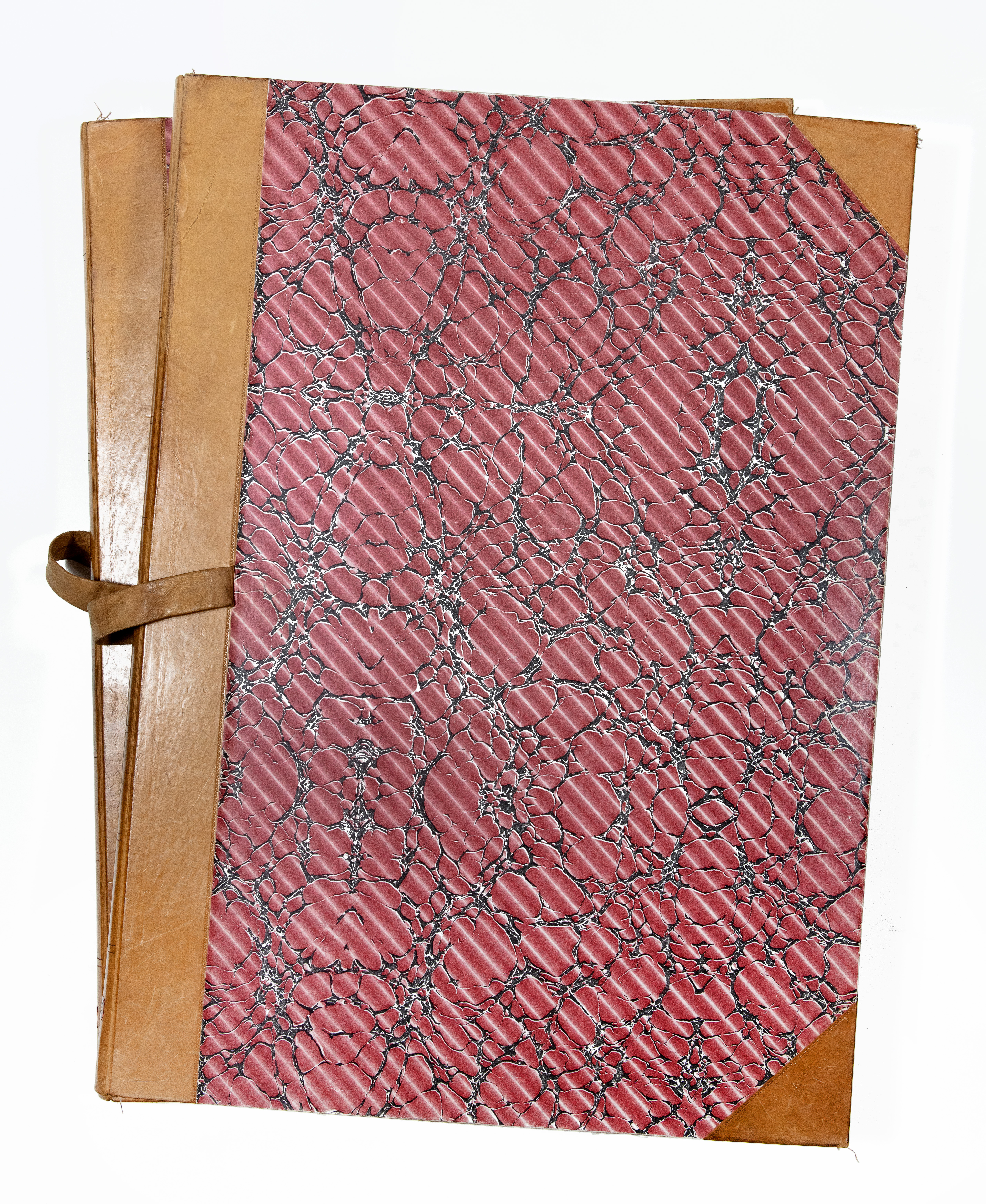 ©Sir John Soane’s Museum. Photo: Lewis Bush |
There have been changes to this volume in the 20th century. In 1979, conservation treatment was carried out to 10 grotesque panels and a folded sanguine and ink drawing by Piranesi, considered the most important in the album, was permanently removed, opened out and mounted.[10] Following external advice that ‘the de-acidifying of every drawing was essential’, and as part of a routine preservation approach at that time[11], the drawings were removed for treatment in 1984 then remounted into two new, stub-guard format, half-leather bindings with marbled paper covered boards[12] (662x482 mm) (Fig. 6). Additional support leaves allowed chalk drawings to be mounted one drawing per opening with facing tissue incorporated at the guard removing the problem of transfer. Further loose sheets are now also inserted between facing drawings with body colour. Increased height of the volume, by 50 mm, allowed some folded drawings to be mounted open and the buckram flaps stopped surface dirt ingress (Fig. 7).
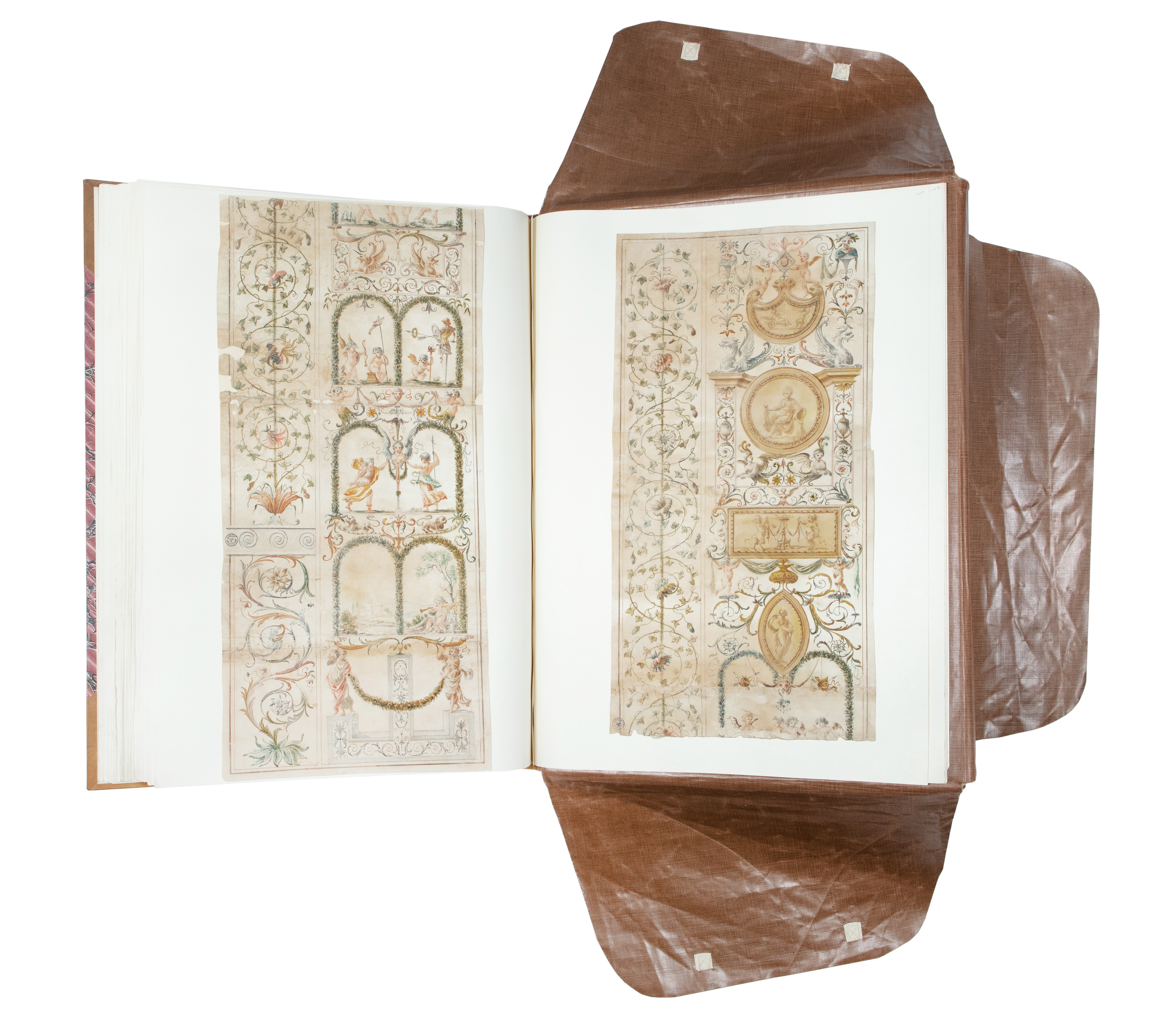 ©Sir John Soane’s Museum. Photo: Lewis Bush |
The original album has been retained and shows all sheets have a crease due to a ‘back mark’ from hanging over ropes in the drying loft during manufacture. This could have contributed to the need for replacement, otherwise they are of a good quality, strong, gelatine-sized nature albeit with discolouration from glue spots and moderate planar distortion. Although treatment or preservation in a new format are implemented in many cases to maximize the useable lifetime of paper objects, monitoring the Adam volumes has shown them to remain well-preserved without intervention. Furthermore, the drawings do not visibly suffer from continued storage in historic volumes and it is evident that the modern bindings and machine-made pages do not add to the interpretation of the 18th-century contents, a loss to both the authenticity and aesthetic of an unaltered composite object.
Recent decisions on preservation have focused on care of the albums, maintaining their extant format as well as access. Digitisation and the creation of an online catalogue with high-resolution images has reduced researchers viewing the volumes and reached a far wider audience. Climate control has been improved through modification of the current heating system helping to stabilise relative humidity. Replacement wood cabinets, of a type chosen for low VOC emissions, were commissioned to house the collection and complement Soane’s furniture. Previously the albums were stored vertically, tightly packed and regular access caused abrasion. They are now singly stored horizontally on rolling shelves. Following a survey by the Curator of Drawings and Books that identified mechanical damage a triage list was prepared and several drawings were repaired, the remainder await funding. A small number of selected drawings are now permanently removed to reduce further risk of damage.[13] However, drawings are occasionally detached for exhibition and replaced into the albums to maintain the format and aesthetic.
The interventions since Soane’s purchase have sought to respect the archaeology of the collection and they reflect the custodial care of the albums and need for access as well as conservation approaches over time.[14] Currently, selective repairs are carried out to enable safe access and all original materials retained for their research significance and to keep Soane’s collection harmonious and intact. Further investigation into the material aspects of the 57 volumes would help to identify original elements, establish the chronology of repairs over 200 years and inform future decisions.
Einzelnachweis
1. Arthur T. Bolton: The Architecture of Robert and James Adam, London 1922, volume 2, pp. 331–333: 1818 sale 2nd day, lot 53 plus other loose drawings later bound. Alan A. Tait: The Sale of Robert Adam’s Drawings, Burlington Magazine, July 1978, pp. 454 plus footnote 27 in reference to 55 volumes.
2. Frances Sands: Robert Adam’s London, Oxford 2016, pp. 4–5.
3. Alan A. Tait: Sir John Soane’s Museum, Collections Online, Robert and James Adam travel drawings, (accessed 31/10/2020).
4. Andrew Robison: Piranesi Early Architectural Fantasies, A Catalogue Raisonné of the Etchings, Chicago/London 1986, pp. 216–223.
5. I am indebted to Dr. Frances Sands, Adam scholar and Curator of Drawings and Books SJSM for the hand attributions.
6. Robert & James Adam‘s Grand Tour letters and writings 1754–63 available via Sir John Soane’s Museum website (accessed 14/12/2022).
7. Andrew Robison: Piranesi Early Architectural Fantasies, A Catalogue Raisonné of the Etchings, Chicago/London 1986, S. 216–223.
8. Georg Kabierske: A Cache of Newly Identified Drawings by Piranesi and His Studio at the Staatliche Kunsthalle Karlsruhe, Master Drawings, Vol LIII No.2 (2015) pp.147–178.
9. Jonathon Yarker: ‘Antique Mad’: the Adams as Dealers and their Stock of Antiquities, in: Colin Thom (ed.): Robert Adam and his Brothers. New Light on Britain’s leading Architectural Family, Swindon 2019, pp. 63–82, p.72.
10. Sir John Summerson: SM Archive, Correspondence with conservator at the British Museum (1977–79) 65,36,57–59.
11. Sir John Summerson: SM Archive, Report to Trustees ‘Conservation of the Soane Drawings’, 1974.
12. Sir John Summerson: SM Archive, Correspondence with conservator at the Public Records Office, August 1984, 1–3.
13. Predominantly large folded works.
14. I am indebted to book conservator Ann-Marie Miller ACR, Codex Conservation, for advice on binding materials and chronology of interventions in several volumes and to Sue Palmer, Archivist and Head of Library Services SJSM for identifying reference material.
GND terms
Permalink | piranesi.kunsthalle-karlsruhe.de/en/essay/4/die-alben-der-brueder-adam-im-sir-john-soanes-museum
The permalink always takes you to the latest version of the article.Citable link | piranesi.kunsthalle-karlsruhe.de/en/essay/4/die-alben-der-brueder-adam-im-sir-john-soanes-museum/1
The quotable link allows you to access this content in the future regardless of any changes made to the text
Comments
This field enables you to leave comments on our objects. These comments will be viewed by our employees and displayed publicly to all readers afterwards.